How to Play Blackjack: Dealer’s Turn, Blackjack & Insurance
How to Play Blackjack: Part 3
Table of Contents
- Dealer’s Turn and Beyond
- Blackjack
- Insurance
- Single Deck and Double Deck
- Situations
- Tipping
- Things I’ve Noticed Working as a Dealer
How to Play BlackjackFurther Reading
- Part 1: How to Play Blackjack for Beginners
- Part 2: How to Play Blackjack: Player Actions (With Hand Signals)
- Part 3: How to Play Blackjack: Dealer’s Turn, Blackjack & Insurance
Did this free course help you?
Click to leave a tip to help keep this resource free!
Dealer’s Turn and Beyond
After all of the players have made their decisions, it is the dealer’s turn. The dealer will always go last and they will always follow the same set of rules; the dealer must hit 16 and lower. The dealer must stay on 17-21, and if the dealer goes over 21 they bust and you win. Depending on the casino some dealers will have to hit a soft 17.
When the dealer is done with his turn he will go and compare your hand with his hand. Whoever is closer to 21 wins the hand. If the dealer wins the dealer will take your bet, if you win then the dealer will pay your bet 1:1. If the hands are the same then this is considered a “Push” and the money will stay where it is, usually the dealer will pat the table to indicate a push.
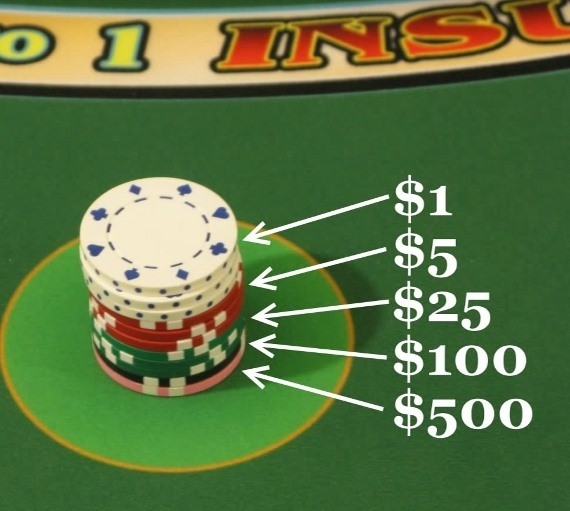
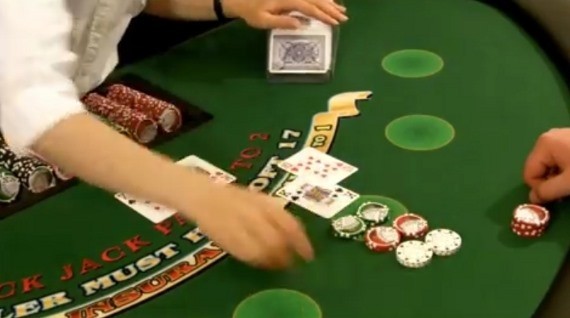
If you are betting with multiple denominations, or a multi-color bet, then when the bet is paid the dealer will break down the bet and it is your responsibility to properly stack up the cheques. To do so, always make sure that the larger denomination is on bottom. For example, if you wanted to bet $73 then you would put your 2 green chips on the bottom, the 4 red chips in the middle and the 3 white chips on top.
Blackjack
If your 1st two cards are of a ten value and an ace then that is considered a blackjack and a blackjack cannot lose. Blackjack gets paid automatically plus you will receive a bonus amount. The blackjack payoff is 3:2 which means the bet gets paid 1 ½ times.
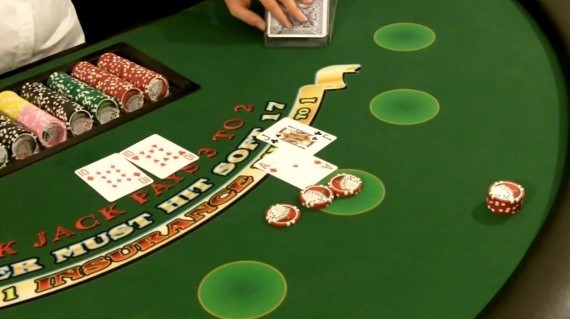
Example:
If you have a $10 bet and receive a blackjack, then you will win $15 total. (10 x 1.5 = 15)
*For a list of blackjack payoffs, click here.
If you and the dealer both get a blackjack then the hand is a push. If the dealer gets a blackjack and you have any other hand, then that is an automatic loss.
Insurance
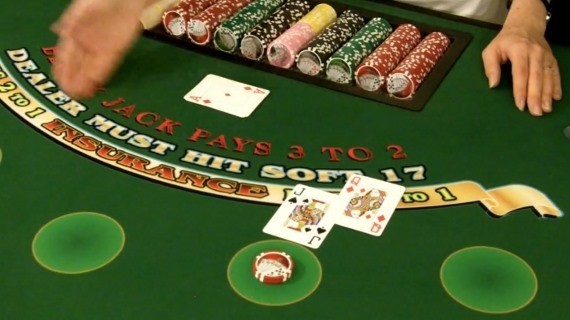
When the dealer has an ace up they will ask for insurance while running their hand alongside the insurance line. Insurance is a side bet, which is a voluntary bet that you can make if you think the dealer has a blackjack. You may only bet half of your original bet; any extra should be given back to you by the dealer. The insurance bet pays 2:1.
If the dealer has a blackjack then you keep your insurance bet plus your original bet. If the dealer does not have a blackjack then you lose your insurance bet.
If you have a blackjack and the dealer asks for insurance and you want to take it because you believe the dealer has a blackjack, then instead of taking insurance you ask for “Even money”. This is the same as if you took insurance, the bonus you get for a blackjack goes to pay for the insurance and you get paid “Even Money”. People do this because it is a sure payoff.
If the player has a blackjack and doesn’t take even money or insurance and the dealer also gets a blackjack then the 2 hands would push.
Single Deck and Double Deck
You just learned how to play blackjack on a shoe game, now it is time to teach you about the other blackjack variations. When you walk through a casino you will see more varieties of blackjack then you thought existed. The single deck and the double deck are the most common versions. There are also “Super Fun 21”, “Blackjack Switch”, “Spanish 21”, “Double Exposure Blackjack”, “Lucky Ladies”, “Royal Match” and much more.
On all types of blackjack games, the player is still expected to make hand gestures to indicate what they want. On a single or double deck, the hand gestures are:
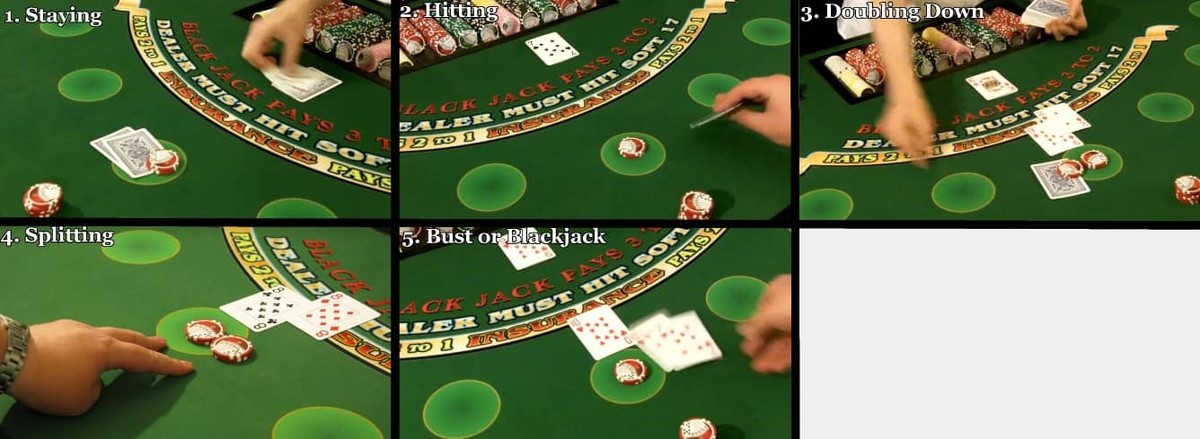
-
Staying – When you want to stay, tuck the corner of your cards under the bet. Don’t touch your cards or bet again until after the hand.
-
Hitting – With the cards in your hand, scratch the table towards yourself. Scratch the layout behind or beside your bet; never scratch your cards in front of your bet.
-
Doubling Down – Put an equal or lessor bet next to the original bet and flip the cards face up. Hold your hand in a fist and extent the forefinger; showing you only want one card. The dealer will give you a card face down. You can wait until the end of the hand to see it or you could peek at the card and know as soon as you get it. It is table etiquette to leave the card facing down once you look at it.
-
Splitting – Put an equal amount next to your original bet and flip the cards face up. Hold up your fist with the forefinger and middle finger making a “V” shape. The dealer will split the cards for you. Use the normal shoe hand gestures to continue playing your hands.
Depending on the casino, you may or may not be allowed to double down after a split.
- Blackjack / Bust – As soon as you bust or get a blackjack, flip your cards over so the dealer can see them. When you hit and get a 21, don’t throw the cards up. You only throw the cards up on a bust or a blackjack.
If you make 21 with your cards this is not a blackjack. Do not flip your cards over expecting an immediate payoff. Please tuck your cards under the bet and be happy that you have a 21.
Here are some differences you will experience between a shoe game and a single deck or double deck.
On a shoe game the cards will be dealt to you face up and you are not allowed to touch them. On a single or a double deck the cards will be tossed to you face down. You are allowed to pick up the cards but you can only use one hand.
On a single deck game, blackjack only pays 6 to 5, whereas on a shoe game blackjack pays 3 to 2. That means on a single deck for every $5 bet you will get paid $6, instead of $7.50 which is what you would get paid on a shoe.
Situations
Here are a few situations that you might find yourself in:
When you hand the dealer money, make sure that the money is not in or anywhere near the betting circles. There have been many times a dealer has mistaken that gesture as a bet and they will start dealing. And once the cards are out you can’t change your bet. So if you don’t want to lose the entire $100 you brought with you on one hand, then make sure that the money is above the betting circle.

When a dealer is done shuffling they might offer you the cut card. A “Cut Card” is the small solid color card that the dealer will hand you. Take that card and stick it somewhere in the middle of the deck that the dealer is holding in front of you. This is called “Cutting the Deck”.

Warning: You can’t imagine what people do with that cut card and it is never washed. So please, don’t kiss, rub it on your face, rub it under your shirt or on other body parts.
After you are done playing and you want to leave the table, it is good to “Color Up”. This means that you give the dealer the stacks of cheques you have in front of you for fewer but larger denomination cheques. When you want to exchange those cheques for cash, then go to the cage.
There is no contact allowed between you and the dealer. The dealer should never touch a player and a player should never touch a dealer.
If you find that you have cheques from a different casino, then you can ask the dealer if they can exchange your foreign cheques for usable cheques. Sometimes they can do it and sometimes they can’t. If they can’t, the next best thing you can do is to go ask the cage if they can give you cash for your foreign cheques. If the cage cannot, then you must go back to that casino to get cash for those cheques.
You are not allowed to use your cell phone on or near the table. People regularly use their cell phones when they cheat, so the dealer will always tell you to get off the phone or get off the table.
There are also certain items you can and cannot place on the table. At the casino I worked at, the dealer’s would have a saying, “If you can’t drink it, smoke it or gamble it then it can’t be on the table”
When entering a new table, it is considered polite to wait until the deck has been shuffled. The reason why is because when a new player enters the game, the order that the cards are going to change and this could sometimes change the game. Making a good shoe turn bad with the addition or subtraction of players. That is why it is good to ask if anyone would mind if you enter the game mid-deck.
Tipping
Casino dealers live on minimum wage and tips. That is why it is always good to tip your dealer. There are two different ways of doing tipping your dealer. The first way is by giving the dealer their tip. You can give the dealer either cash or cheques; just push it towards the middle of the table and tell the dealer “This is a tip.”
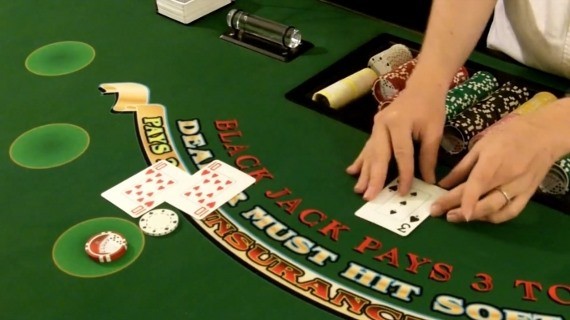
The second way you can tip the dealer is by betting their tip with your bet. Take the amount of cheques that you want to tip the dealer and place it in front of the betting circle. If you win then the dealer wins; but if you lose the dealer loses too. Now a days, the dealers don’t keep their own tips. The tips are collected in a 24 hour period and then split equally among all of the dealers based on the number of hours they worked.
Things I’ve Noticed Working as a Dealer
Anytime you are in a casino, keep your eyes on the floor, especially under the tables. Because drunk people drop chips and don’t realize it so you can find anywhere from $1 to $100. Usually it will be a $5 cheque, but once I found a $5,000 cheque under the table.
If you're on a winning streak then just gamble with that dealer. If a dealer is giving away money, they will usually continue for the rest of their shift.
If you are losing, don't keep pulling out more money because you think your luck is going to change. You'll just lose a large sum of money and be extremely mad. Instead, take a break, go somewhere else or try another game.
Thank you for reading and remember that gambling is a form of entertainment, not a way to pay bills.
